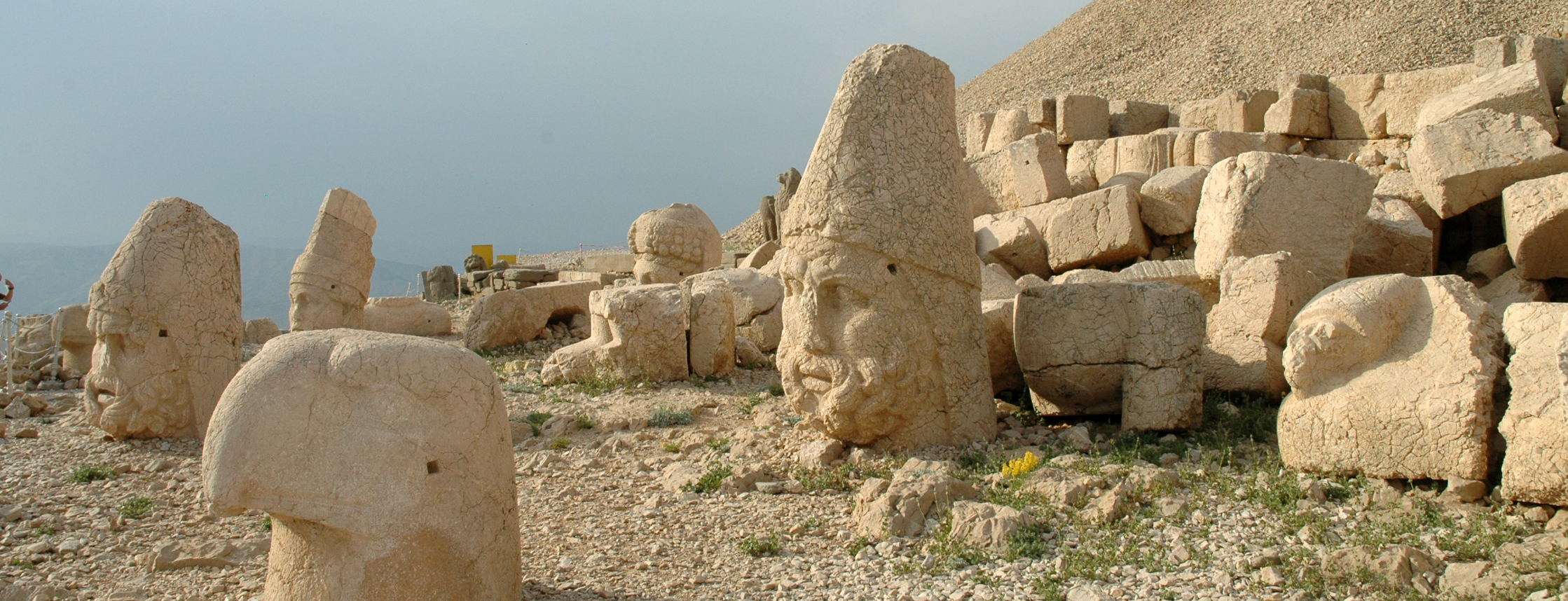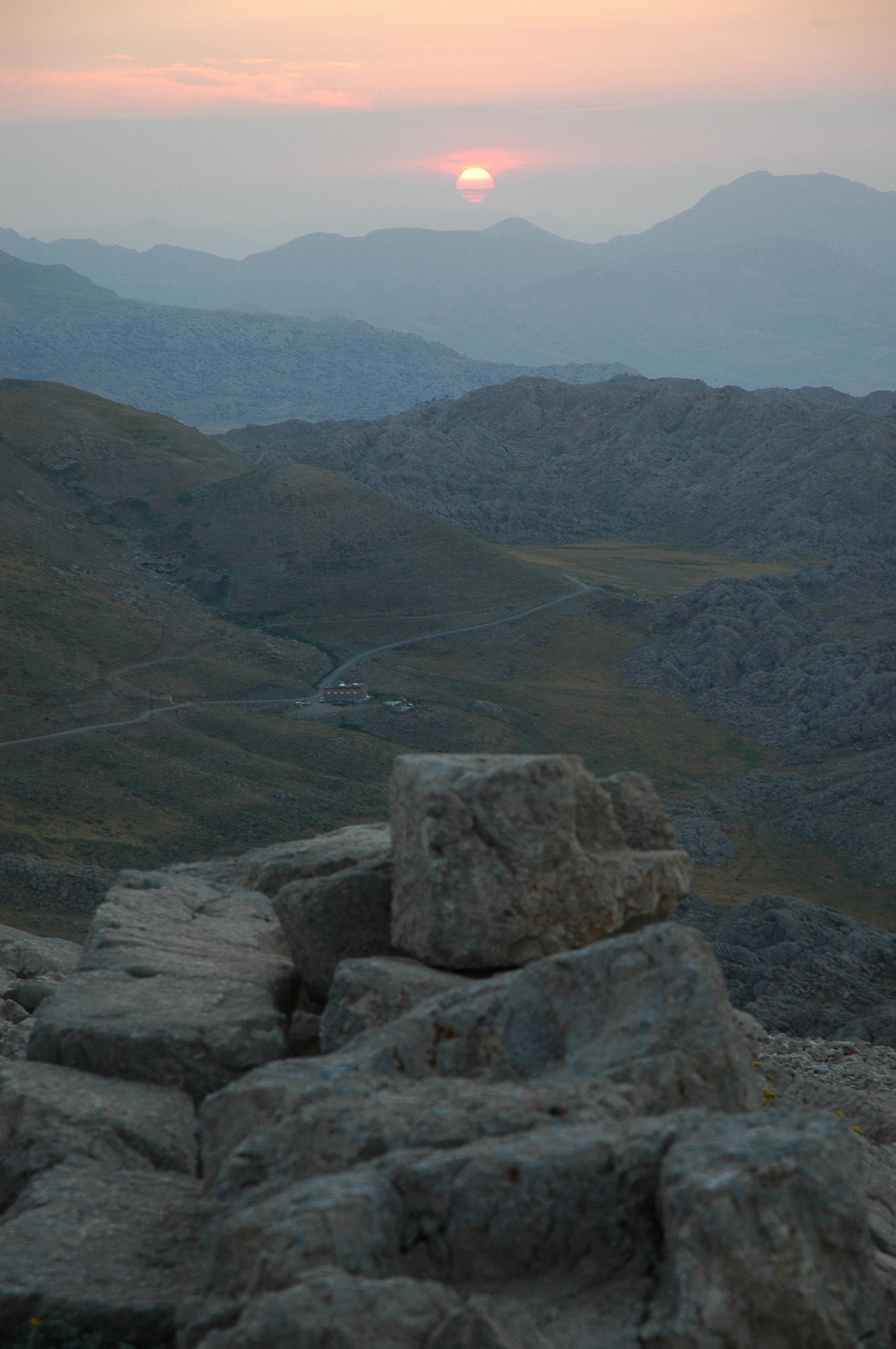Astronomy in Nemrud Dag: a new perspective (see here and below)
Astronomía en Nemrud Dag: una nueva hipótesis
Imagen del hierothesion de Antíoco I, rey de Comagene, en Nemrud Dag (© M. Sanz de Lara).

Image of the hierothesion of Antiochos I, King of Commagene, at Nemrud Dag (© M. Sanz de Lara)
Uno de los principales hitos de nuestro trabajo ha sido un análisis novedoso del monumento funerario de Nemrud Dag, en Turquía, publicado en el volumen 41 del Journal for the History of Astronomy (Belmonte & González García, JHA 41, 469-81). El hierothesion de Antíoco I, rey de Commagene en Monte Nemrud --que es patrimonio de la humanidad--, constituye sin duda uno de los más fascinantes enigmas históricos de la cultura humana en todo el mundo. El monumento incluye el famoso "Horóscopo" del león, que a menudo ha sido utilizado en intentos diversos para interpretar y fechar las ruinas con resultados controvertidos. Sin embargo, después de una visita al monumento, con la observación local del amanecer en el solsticio de verano de 2009, nuestro grupo ha propuesto una explicación alternativa y mucho más justificada que involucra no sólo el friso del león sino también y más importante, la orientación de las terrazas oriental y occidental del hierothesion así como la tradición religiosa del país. Nuestros principales resultados pueden resumirse como sigue: por un lado, las cinco estatuas ciclópeas de la terraza oriental habrían estado dirigiendo su mirada al sol naciente seguido por el orto (oscurecido por el brillo solar) de sus manifestaciones celestiales (los planetas) en la constelación de Leo el 23 de julio del año 49 a.C., en conmemoración del ascenso al trono de Antíoco I, como se menciona explícitamente en las inscripciones del sitio llamadas nomos; por otro lado, unos meses más tarde, sus equivalentes de la terraza occidental habrían estado enfrentandos a la puesta del sol el 23 de diciembre de ese mismo año, 49 a.C. en conmemoración del aniversario del rey. En consecuencia, de acuerdo con nuestra propuesta, los principales elementos de las terrazas oriental y occidental del hierothesion habrían sido deliberadamente alineados con el amanecer del 11 de Loios y el atardecer del 16 de Audnayios, respectivamente, en el año 49 a. C., fechas mencionadas en el nomos. En consecuencia, el horoscopo del león debiera ser adjudicado ahora la 12 de julio de 49 a.C. Así pues, nuestra conclusión es que el monumento de Antíoco refleja la situación de los cielos en momentos exclusivos del año 49 a.C., lo que que vendría avalado por la inscripción monumental del lugar. Este hecho representa un cambio completo de paradigma con respecto a lo asumido
hasta la fecha.
Salida del sol en el solsticio de verano en Nemrud Dag (© M. Sanz de Lara)

Summer solstice sunrise in Nemrud Dag (© M. Sanz de Lara)
One of the main highlights of our work has been the analysis of the burial monument of Nemrud Dag, in Turkey, published in volume 41 of the Journal for the History of Astronomy (Belmonte & González García, JHA 41, 469-81). The world heritage site of the hierothesion of Antiochos I, King of Commagene, at Mount Nemrud certainly constitutes one of the most fascinating historical enigmas in human culture worldwide. The monument includes the famous lion “horoscope” which has often been used in various attempts to interpret and date the ruins with controversial results. However, after a visit to the monument, with on site observations, in the summer solstice of 2009, our group has proposed an alternative and more substantiated explanation which deals not only with the lion slab but also, and most important, with the orientation of the eastern and western terraces of the hierothesion and the religious tradition of the country. Our main results can be summarized as follows. On the one hand, the five cyclopean statues of the eastern terrace would have been facing sunrise followed by the rising (obscured by the solar glare) of their celestial manifestations (the planets) in the constellation Leo on July 23 49 B.C., commemorating Antiochos' ascent to the throne as explicitly mentioned in the nomos inscriptions on site. On the other hand, a few months later, their equivalents of the western terrace would have been facing sunset on December 23 49 B.C. in commemoration of the king's birthday. Consequently, according to our proposal, the main elements of the eastern and western terraces of the hierothesion should have been deliberately aligned to sunrise of Loios 11 and sunset of Audnayios 16, respectively, in the year 49 B.C. The lion´s horoscope should consequently be redated to July 12 49 B.C. Our conclusion is that Antiochos’ monument reflects the situation of the skies at exclusive moments of the year 49 B.C. as confirmed by the local monumental inscription or nomos. This represents a paradigmatic change to well established theories on the interpretation of the monument.